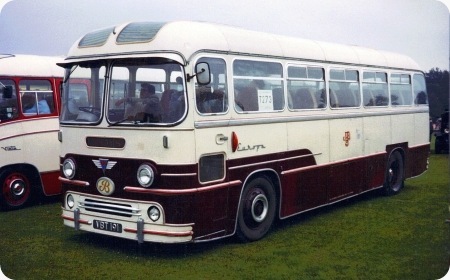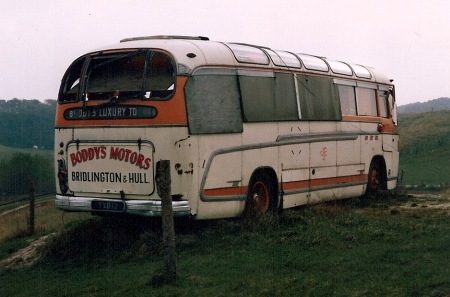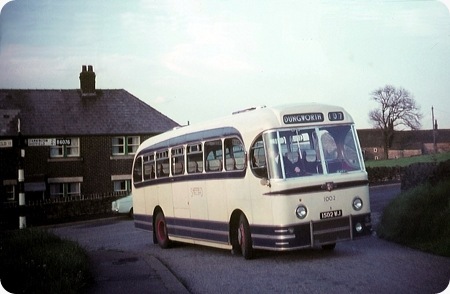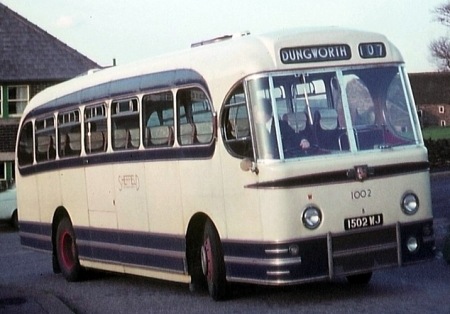Boddy’s Coaches – AEC Reliance – VBT 191
Boddy’s Coaches (Bridlington)
1958
AEC Reliance MU3RV
Yeates C41F
In 1958, Boddy’s Motors (John Boddy & Son) purchased a trio of AEC Reliances type MU3RV, which were bodied by Yeates with their Europa bodywork. There was seating for 41 passengers and was fitted with front entrance and exit doors. The first two VBT 191/2, were to service in May, 1958, whilst the third VBT 893 entered service the following month. I am unaware what happened to these three upon withdrawal, but one, VBT 191, survived into preservation. It had chassis number 823 and Yeates body number 658. The photograph shows this vehicle at the Harrogate end of the Trans-Pennine Rally, which commenced in Manchester. It is seen on the Stray, Harrogate on Sunday August, 1985.
Photograph and Copy contributed by Keith Easton
A full list of Reliance codes can be seen here.
19/06/11 – 11:41
191 was sold to Yeates at there co Durham branch supposedly for preservation 192 was stripped of all useful mechanical and body trim and the shell went to a local haulage contractor as a store shed at a yard at the side of the railway at flambro until it was broken up when a new owner took over. 893 was sold earlier than the other two I believe to a Lancs operator. 191 appeared later with Mathers Motors in the Scottish Borders, it then went to Skegness and I understand it is now with Fowlers in Lincs. They were very pleasant coaches to drive and the exhaust brakes made a loud noise when coming to a stop every one turned round to see what was coming
Ken Wragg
19/06/11 – 20:52
Kens notes reminded me that I managed to get a photo of VBT 192 at Askham Caravan Transport in Flamborough on 14/9/82 a sad end to a fine coach.
YXD 12 was another sad end this fine vehicle ended up as a club house at a Hunmanby race track seen in 26/10/87 see below
Mike Davies
20/06/11 – 15:03
Mike, was YXD 12 a Duple Britannia ?? I think it looks like one – Wallace Arnold had just three of those, 4324/5/6 UA and I thought they were beautiful. On the East Yorkshire theme, I once took 4324 empty to Hull, had B & B in the City Centre, and then took a full load to Southend Airport next day (one of my favourite runs) to hop across to the Continent for their holidays in one of the Channel Airways Dakotas. Wallace Arnold had a huge programme based on Southend Airport in those adventurous days in the early 1960s.
Chris Youhill
21/06/11 – 07:41
YXD 12 was an AEC with duple Britannia body. with 40 seats only 4 across the back seat however it was possible to get 5 on the back and very often 1 on the courier seat this was a very nice coach to drive with air brakes
Ken Wragg
21/06/11 – 07:43
Yes, Chris, it’s the final manifestation of the Britannia before the Continental – and subsequently the Commander – took over as the AEC and Leyland body by Duple. I agree with you about its looks.
David Oldfield
21/06/11 – 07:47
Re VBT 191..Tonight I did a DVLA check and found that it is not listed on their records so at best is not currently taxed unless it has lost it’s original registration number. I then researched the website of Fowlers Travel and found that they have a complete list of every coach they have had since they started with details of when bought, date of disposal and to whom it was sold or scrapped. Sadly, the AEC is not listed as far as I can see.
You can view the list here..
It will be a real shame if the coach fell into poor hands after being preserved.
Richard Leaman
21/06/11 – 16:03
Yes Chris YXD 12 was Duple Britannia, interestingly Hoods of Wold Newton, which is not to far from Bridlington had YXD 14 I don’t remember seeing it, and have not got a photo.

Another ex Boddys vehicle which I managed to photograph was RN 8672 in use as a store shed at Octon Lodge Farm, Octon. this has since gone on to one of the Ribble preservation groups I think.
Mike Davies
22/06/11 – 07:10
VBT 191 is alive and well and appeared at this year’s UK Coach Rally at Peterborough.
MikeB
22/06/11 – 07:13
If you Google the registration VBT 191, it comes up with a very nice photo on Flickr of VBT 191 at the UK Coach Rally in April of this year.
The Fowlers listing given by Richard seems to omit vehicles they have acquired for preservation, as they also have 966 RVO, a Yeates bodied VAL new to Barton Transport.
Bob Gell
22/06/11 – 13:17
Thank you Mike and Bob. Good news indeed but puzzling that it is not found on the DVLA records which is why I feared it might be lost. Maybe there has been a change in it’s details recently and been temporarily off record as happened to a car I sold last year.
Richard Leaman
26/06/11 – 08:09
VBT 191 is on the DVLA website-classed as a Leyland AEC
VBT 893 left the fleet as early as July 1966, and passed to an operator called Davies of Halewood.
Further to Keith Eastons earlier post-I have a fleet list for Annfield in JPEG format-probably (certainly!) incomplete.
David Hick
26/06/11 – 11:27
Such a fleet list, complete or otherwise, would be most interesting to we older "Bridophiles" David if there is any possibility please.
Chris Youhill
27/06/11 – 07:09
Davies of Halewood, eh? The last ever delivery of a RELH to an independent operator was to them. [The previous such – and the first – was to Flights.]
David Oldfield
29/06/11 – 14:37
Hello just want say I have a great interest in the Willlamsons coaches and am trying to find out as much info as possible as my family are related to them; my nana was a Williamson her Grandad was Reuben Williamson . She would recall living in Brid among all the coaches . she told us they owned horse drawn coaches before the motorised vehicles in Havelock Crescent . She moved away from Brid in her late teens and sadly passed away 2 weeks ago aged 96. This why it is of great interest to me…
Anon
01/07/11 – 05:34
RWF 785 , another former Boddy coach, can be found here: //www.flickr.com/
David Hick
01/07/11 – 09:25
Hello Anon, and firstly we’re very sorry to hear of your Grandma’s passing away. I’m not good on "family trees", but would the lady’s father possibly have been Tim Williamson ??, as he was the son of Reuben and ran the business till the sale to EYMS. My Grandma and my Aunt knew Tim in the old days – they ran a very small B & B in St. Stephen Road.
Chris Youhill
08/10/11 – 06:18
…all this talk of Body’s etc. sent me to my ticket collection of which I have
‘BODDY’S MOTOR TOURS’ at 101 Promenade and 10 Hilderthorpe Road BRIDLINGTON.
– also (to make Mr. Youhill dribble are scans I have done (Front and Back) scans of his ‘beloved’ WILLIMSON’S punch tickets showing ‘Havelock Crescent’ on reverse self message.
‘Coming Soon’ as they say to the Old Bus Tickets web site.
Peter Abel
08/10/11 – 17:23
Now then Peter A, a very good job I had a bib to hand as I’m already dribbling in anticipation !!
Chris Youhill
10/10/11 – 06:34
Ain’t we all! Cant wait to see the Boddy’s ticket
Keith Easton
12/01/12 – 06:45
Peelings of Tittleshall had YXD 10 a very similar Reliance.
Jonathan Joplin
18/07/21 – 06:28
VBT 191 is now in the heritage fleet of Thornes Independent, Hemingbrough near Selby, North Yorkshire.
Mr Anon








